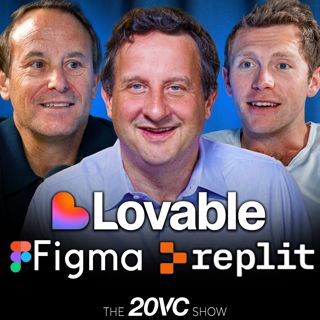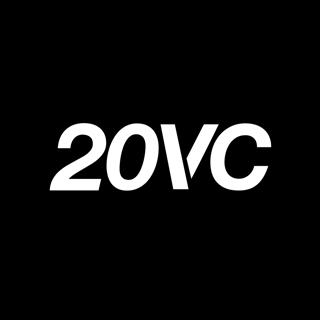
20VC: Inside Carnegie Mellon's $4BN Endowment | Why 90% of LPs Shouldn't Invest in VC | The $140BN Problem with Multi-Stage Funds | The Hidden Math Behind DPI, TVPI, and Illiquidity with Miles Dieffenbach
Miles Dieffenbach is Managing Director of Investments at Carnegie Mellon University, where he helps oversee a $4 billion endowment with a focus on venture capital, private equity, and alternative investments. Under his leadership, CMU's private book has remained self-funding during some of the toughest years for liquidity. Agenda for Today: 00:04 – "I Had Cancer at 26 – It Changed Everything" 07:00 – Inside the $4BN Carnegie Mellon Endowment: The Investment Blueprint 10:45 – Are LPs Getting Screwed in Venture? 13:30 – 90% of LPs Shouldn't Be in Venture – Here's Why 16:00 – Seed Funds Are a Trap (And No One Wants to Admit It) 20:00 – The $140BN Problem with Multi-Stage Funds 24:00 – "Index Is the Best in the Game – Here's Why They Win" 29:30 – "The Dirty Secret of LPs: Brand Over Performance" 34:30 – "When Founder-Friendly Goes Too Far" 38:00 – "The OpenAI Bubble – Will It All Go to Zero?" 44:00 – "Ping Pong Diligence & Wildest Fundraising Stories"
4 Elo 1h 27min

20VC: Benchmark Loses Another Partner | Elad Gil Raises a Monster $1.5BN Solo GP Fund | Why Apple Need a Management Overhaul | Why Google is the Best Performing Hyperscaler | Will Cursor Hit $4BN ARR & Lovable $400M ARR by EOY 2026?
Agenda: 00:00 - Why Benchmark Is Bleeding Partners (and Why That's the New Normal) 04:57 - "I Wouldn't Leave Benchmark… Unless I Had THIS" — Jason on Brand vs Autonomy 09:01 - The Rise of the Solo GP & The Death of LP Conventional Wisdom 13:50 - The Unstoppable Force of Elad Gil & The Myth of LP Discipline 18:45 - Is Vibe Coding the New SaaS? Jason's $10K/Month Spend Reveal 26:57 - Cursor's Growth Is Insane—But Is It Sustainable? 31:44 - Will Microsoft, Google, or Amazon Win the AI Infra War? 37:42 - Is GitHub Copilot the Biggest Miss in Microsoft's History? 44:15 - Are Big Tech Incumbents Now Too Powerful to Fail? 48:00 - Apple's AI Problem: Is It Time for a Management Overhaul? 52:30 - Figma's IPO: $30B Return, Zero Hype. What Happened? 1:06:00 - Final Bets: Cursor to $4B ARR, Lovable to $400M ARR, OpenAI to $800BN?
31 Heinä 1h 21min

20VC: a16z's Martin Casado on Anthropic vs OpenAI: Where Value Accrues | Cursor vs Replit vs Lovable: Who Wins and Who Loses | The One Sin in AI Investing | Why Open Source is a National Security Risk with China
Martin Casado is a General Partner @ a16z where he leads the firms $1.25BN infrastructure fund. At a16z, Martin has led investments in companies like Cursor, dbt Labs, and Fivetran to name a few. Before joining a16z, he co-founded Nicira, acquired by VMware for $1.26B. At VMware, he served as CTO of Networking. Widely regarded as a visionary in enterprise infrastructure, Martin has helped shape the modern cloud computing stack. Agenda: 00:00 – Analysis of Current AI Investment Landscape 04:45 – Will Anthropic Kill the AI App Layer? 09:20 – "The Oligopoly Is Coming—Just Like Cloud" 12:50 – Are AI Models Actually Terrible Venture Investments? 15:40 – Why it is BS to Put Down AI Apps for Having Temporary Revenue 21:30 – "Open Source Is a National Security Weapon—And We're Losing" 26:40 – "Have the Foundation Models of the Future All Been Founded Already" 34:30 – Why it is BS to Denigrate AI Apps for Having Low Margins 38:40 – Does AI Make 1x Engineers 10x or 10x Becomes 100x 44:10 – "We're All Dead Wrong About AI and Job Loss" 50:30 – "The Only Sin in Venture: Backing the Wrong Winner" 55:10 – What People Think They Know About Wealth But Do Not
28 Heinä 1h 10min

20Product: Should We Kill the PM Role Entirely | How Does Product Design Change Most in a World of AI | How Do Monzo Build Product Today: What Works, What Does Not | Why Most Product Sucks and What Makes Truly Great Product
Fernando Fanton is one of the most respected product leaders in Europe, having held Chief Product Officer roles at Monzo and Just Eat. He previously led product and tech at Rappi, one of Latin America's most valuable startups. Today, Fernando is the CPO @ Property Finder; one of the biggest breakout unicorns from MENA. Agenda: 00:00 – Is "having a vision" actually killing great product teams? 03:15 – Why do most products suck—and what separates the great ones? 07:20 – Should we kill the PM role entirely? Fernando says maybe. 11:45 – Is Monzo's obsession with trust more powerful than speed? 16:10 – What's the #1 reason internal tools will never replace SaaS? 21:00 – Will AI wipe out the need for designers and PMs? 26:30 – Is it arrogant for product teams to protect users from "bad" choices? 32:15 – What's the future of product when OpenAI controls the whole stack? 37:40 – What Monzo product blew up—and why no one saw it coming? 42:55 – Can a bank built on principles really become a $100B company?
27 Heinä 1h 7min

20VC: Lovable Raises at $2BN & Hits $100M ARR | Is Cursor Worth $28BN at $1BN in ARR | How Do All Providers Deal with Anthropic Dependency Risk | Are Seed Funds F******: Have Mega Funds Won | Figma IPO Breakdown: Where Does it Price?
Agenda: 00:00 – Did Jason Just Kill Replit? 03:45 – Why Claude Lies To You and Cannot Be Trusted 06:50 – You Cannot Trust Agents. Period. 10:20 – Why Windsurf Was Dead Without Claude 12:30 – Cursor vs. Lovable: What's the Better Bet? 14:40 – Should You Still Invest in Cursor at $28B? 18:05 – Would You Bet on Anthropic at $100B or OpenAI at $300B? 24:15 – Inside OpenAI's Secret Weapon: The Calvin French-Owen Memo 27:50 – Perplexity Just Crushed ChatGPT and Claude 32:15 – Will Cursor Build Their Own Models Before Anthropic Cuts Them Off? 33:20 – Figma's IPO at $16B: Outrageous or Fair Game? 41:55 – 90% of Seed Funds Are Cooked—Is Rob Go Right? 52:15 – How Often Do You Meet a Founder Who Can Return the Fund? 1:08:00 – Which Seed Fund Would You Back Today?
24 Heinä 1h 21min

20VC: Scaling to $1BN+ in Revenue with No Funding: Surge AI | The Most Insane Scaling Story in Tech |
Edwin Chen is the Founder and CEO of Surge. Founded in 2020, Surge has scaled to $1BN+ in revenue with zero external funding. At the same time, their competitor, Scale.ai raised over $1.3BN to reach $850M ARR. Today, Surge have the world's largest model providers as customers and have just 120 employees. Agenda: 00:00 — "Everyone Else Is Just a Body Shop" — Edwin Calls Out the Whole Industry 01:05 — Why 90% of Big Tech Is Wasting Time on Useless Problems 03:45 — "I Don't Do 1-on-1s" — How Surge Kills Meetings and Still Moves 10x Faster 05:55 — Will a Single Person Build a $1B Company? 08:10 — 100x Engineers Are Real — Here's How to Spot Them 12:10 — Why Most PhDs Are Useless in AI Training 14:20 — Built to a Billion With Zero VC — Edwin Explains How and Why 17:00 — "No Sales Team, No PR, No BS" — Why Surge Stays in the Shadows 21:15 — The Real Reason AGI Might Take Until 2040 24:45 — Will Synthetic Data Kill Human Labelling? 29:00 — "Academic Benchmarks Are a Scam" 31:05 — Why the Real Bottleneck in AI Isn't Compute or Models — It's THIS 33:00 — What Every AI Company Should Be Asking (But Isn't) 35:15 — "No, I Wouldn't Sell Surge for $100B" 39:00 — Is the Application Layer Doomed? Edwin Predicts the Future of AI Startups 46:30 — Have the Leading Foundation Models Already Been Founded? 48:10 — AGI Could Be Dangerous — And Most People Are Ignoring Why 20VC: Scaling to $1BN+ in Revenue with No Funding: Surge AI | The Most Insane Scaling Story in Tech |
21 Heinä 1h 6min

20VC: Cognition CEO Scott Wu on Acquiring Windsurf: The Process, The Deal, The Rationale | Did Google Overlook a Goldmine in the Core Asset and Did Founders Leave a Sinking Ship | How Cursor and Cognition Deal with Ever Increasing Reliance on Anthropic
Scott Wu is the co-founder and CEO of Cognition, the company behind Devin, the world's first AI software engineer. On Friday last week they pulled off the acquisition of the year, acquiring Windsurf, following their licensing agreement with Google. Previously a world-class competitive programmer, he was a gold medalist at the International Olympiad in Informatics and a member of the U.S. Math and Physics Olympiad teams. Before Cognition, he was a founding engineer at Scale AI, helping shape the early AI infrastructure stack. AGENDA: 00:00 – Why are founders walking away instead of going down with the ship? 01:05 – How did Cognition pull off the $220M Windsurf deal in just 72 hours? 04:45 – What really happened behind closed doors the weekend Windsurf was acquired? 07:15 – Did Google overlook a goldmine in the Windsurf team and IP? 09:00 – Who are the 100 people that secretly shape the future of AI? 12:30 – Can application startups ever gain leverage over foundation model giants like Anthropic? 14:15 – Is coding about to be replaced by simply describing what you want? 17:30 – 50% of new code is AI-written. Where does that go next? 20:45 – "We've gone from 0 to $80M ARR in 6 months. Quietly." 25:00 – Are IDEs and agents just the training wheels for the real future of software engineering? 28:20 – If you could only back one—OpenAI or Anthropic—who's the better bet? 30:00 – Why has Cognition kept its insane growth a secret… until now?
18 Heinä 48min

20VC: Windsurf x Google x Cognition: Full Breakdown: Who Made Money, Who Did Not | Lovable vs Replit: Will These Be $100BN Businesses | Why Elon Could Beat Sam Altman with the New Grok | Why Every S&P 500 Company Will Buy Bitcoin?
Agenda: 00:00 Windsurf was dead—then this deal changed everything 05:00 The Windsurf x Google x Cognition saga explained 09:00 The OpenAI deal collapsed—what really happened 15:00 FTC rules forced a brutal deal structure—who lost? 17:00 The investors' returns: who actually made money? 21:30 Will Google's corp dev team get fired over this? 23:00 Cognition's genius $220M acquisition of Windsurf: Most brilliant Deal of the Year 26:00 The biggest recruiting flex in Silicon Valley this year 35:00 "Roll your own SaaS" is complete nonsense 38:00 Lovable vs Cursor vs Replit: who wins the coding war? 41:00 Why Lovable could be the ChatGPT of builders 44:00 Will these vibe-coded apps become durable businesses? 48:00 The shocking churn rates hidden inside AI SaaS 55:00 Are these $2B valuations actually... cheap? 56:30 Grok just destroyed GPT-4 in benchmarks—WTF?! 01:01:00 Why Grok might overtake OpenAI in the next 12 months 01:11:00 Meta just invested $3.5B in Ray-Bans—WTF? 01:12:30 Should every S&P 500 company buy Bitcoin now? 01:15:00 Will Meta kill open source? What happens to Llama 5?
17 Heinä 1h 21min






















